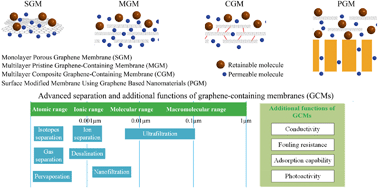Membranes prepared from graphene-based nanomaterials for sustainable applications: a review
Abstract
Graphene-based nanomaterials are versatile functional materials with extraordinary properties. Graphene-containing membranes (GCMs) are advanced separation devices constructed from or modified by graphene and its derivatives; these membranes not only present attractive functions and performance but also generate less residual nanomaterials afterwards, thus lowering impacts to the environment compared to those caused by directly using graphene-based nanomaterials. Since GCMs demonstrate significant sustainability in various applications, they have attracted tremendous attention from both academia and industry. To summarize the state-of-the-art works and guide the future development of GCMs, a full survey of the theoretical and experimental approaches using graphene-based nanomaterials to construct new membranes and modify existing membranes is provided in this review. GCMs are divided into monolayer porous graphene membranes (SGMs), multilayer pristine graphene-containing membranes (MGMs), multilayer composite graphene-containing membranes (CGMs), and conventional membranes modified with graphene-based materials (PGMs). Subsequently, the applications of GCMs in isotope separation, gas separation, desalination, ion separation, nanofiltration, ultrafiltration, and pervaporation are summarized. Multifunctional GCMs with conductive, antifouling, adsorptive, and photoactive properties are also illustrated. The environmental impacts of graphene-based nanomaterials and the safe-by-design concept for GCMs are subsequently discussed. The mechanisms behind GCM construction and GCM performance/function are highlighted. In addition to the advantages of graphene-containing membranes over conventional membranes, the challenges during GCM fabrication and their limitations are analysed to envision the development of next-generation graphene-containing membranes.



 Please wait while we load your content...
Please wait while we load your content...